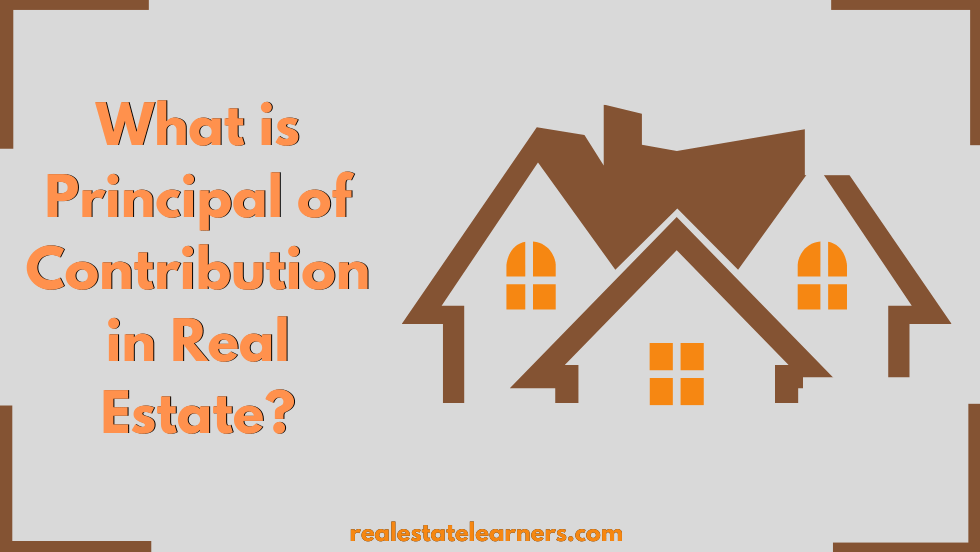Real estate is a major sector of the global economy, with trillions of dollars being invested in it every year. This investment comes from various sources such as individual investors, institutional investors, and governments. One key concept that drives the real estate industry is the principle of contribution. Every student going to appear for real estate agent and active agents should have a sound understanding of this principle.
What is principal of contribution in real estate?
The principal of contribution in real estate refers to the concept that a property’s value is influenced by its surrounding properties and neighborhood. Essentially, it means that a property’s value is not solely determined by its own individual characteristics, but also by the overall market and location.
This principle is important for both buyers and sellers to understand. For buyers, it means that they should pay attention to the neighborhood and surrounding properties when considering a property’s value. A seemingly great deal on a house may not be so great if it is located in a declining or undesirable area.
For sellers, understanding the principle of contribution can help them price their property appropriately. Even if their own property has high-end features and upgrades, they may need to lower their asking price if similar properties in the neighborhood are not selling for as much.
Additionally, the principle of contribution highlights the importance of appraisals in real estate transactions. Appraisers take into account not only a property’s individual characteristics, but also its surrounding area and comparable properties when determining its value.
What is an example of principle of contribution?
Example 1.
For example, let’s say a buyer is looking at two similar houses in different neighborhoods. House A is located in a highly sought-after area with good schools and amenities nearby. House B is located in a less desirable neighborhood with lower-rated schools and limited amenities.
Despite having the same size and layout, House A is priced significantly higher than House B because of its location. This is an example of the principle of contribution in action. While House B may have some attractive features on its own, its value is primarily determined by its less desirable location.
In contrast, even if House A had some minor flaws or needed some updates, it would still likely be more valuable because of its prime location and surrounding area.
Example 2. Another example of the principle of contribution can be seen in commercial real estate. Let’s say a retail store is considering opening a new location in a shopping center. They may be hesitant to pay top dollar for a space if other stores in the same shopping center are struggling or have recently closed down.
In this case, the value of the retail store’s potential location is not solely based on the space itself, but also by its contribution to the overall success of the shopping center. If the surrounding stores and neighborhood are thriving, it is likely that the retail store’s sales and success will be positively impacted.
What are some factors that can affect contribution in real estate?
There are several factors that can affect the principle of contribution in real estate. These include:
Location: As mentioned before, a property’s location plays a significant role in its value and contribution to the surrounding neighborhood. A prime location with desirable amenities and proximity to schools, shopping, and transportation can increase a property’s value and contribution.
Market conditions: The overall health of the real estate market can also impact a property’s contribution. In a seller’s market with low inventory and high demand, a property may have a higher contribution due to increased competition among buyers. On the other hand, in a buyer’s market with an oversupply of properties, a property may have a lower contribution.
Surrounding properties: The condition and value of neighboring properties can also affect a property’s contribution. If there are several well-maintained homes and desirable amenities in the area, it can boost a property’s value and contribution. However, if there are abandoned or dilapidated properties nearby, it can negatively impact a property’s value.
Upgrades and renovations: The features and upgrades within a property can also contribute to its overall value. A home with modern amenities and high-end finishes may have a higher contribution compared to a similar property without these features.
Economic factors: Economic factors such as interest rates, employment rates, and inflation can also play a role in the principle of contribution. For example, if interest rates are low and the job market is strong, more buyers may be able to afford a higher-priced property, increasing its contribution.
What are Different Types of Principles?
There are different types of principles of contribution that can impact a property’s value. These include:
Principle of Substitution: This principle states that a buyer will not pay more for a property than what it would cost to purchase a similar property with the same features and amenities. In other words, if there are multiple properties available in the same area with similar characteristics, the one with the lower price will have a higher contribution.
Principle of Regression: This principle states that a property’s value can be negatively impacted by surrounding properties that are of lesser quality or in less desirable areas. In this case, even if a property has high-end features and upgrades, its value may decrease if it is surrounded by less desirable properties.
Principle of Progression: Conversely, this principle states that a property’s value can be positively impacted by surrounding properties that are of higher quality or in more desirable areas. In this case, the value of a property may increase even if it does not have as many features or upgrades compared to neighboring properties.
Principle of Anticipation: This principle states that a property’s current value can be affected by its potential for future development or changes in the surrounding area. For example, if there are plans for a new shopping center or park to be built near a property, its value and contribution may increase.
Conclusion
In conclusion, the concept of contribution in real estate plays a crucial role in determining property ownership and rights. The principal of contribution is based on the idea that each co-owner should bear a proportionate share of any expenses or benefits that arise from the joint ownership.
This principle also applies when it comes to making improvements or repairs to shared property. It ensures fairness and equity among co-owners and helps to minimize conflicts and disputes.

Corey has over 15 years of experience as a real estate broker and educator. He is dedicated to providing valuable insights and guidance for those looking to enter the real estate industry.

